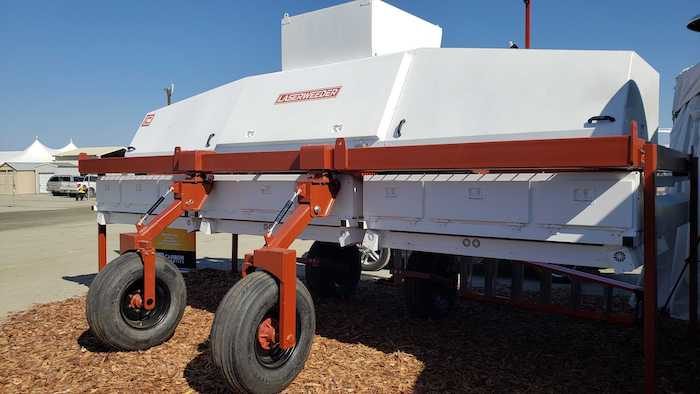In his Upstream Ag Insights newsletter, analyst Shane Thomas says if on-the-combine attachments that destroy weed seeds become mainstream, they could significantly help lower the tolerance for weed seed escapes in a specific area.
He noted the ongoing artificial intelligence (AI) going into sprayers and harvesting equipment illustrates “why equipment companies are strongly positioned in the fight against resistance weeds and supporting the sustainable production of crops around the world.”
Global Neighbor Inc.'s Weed Seed Destroyer and Carbon Robotics' LaserWeeder are two notable examples, Thomas says. The Weed Seed Destroyer uses a blue light treatment to render tough, chemical-resistant weed seeds unable to germinate.
“We found light energy from the bluish-purple segments of the visible light spectrum, along with mid-range infrared rays, damages cells near the seed’s surface responsible for root development,” says Jon Jackson, president of Global Neighbor. “The treated seed is still healthy, but it is incapable of physical germination and the production of a radicle. The seed cannot establish itself in the field.”
"The combine with tools bolted onto it will be a key part of strong herbicide/weed management," Thomas writes. "When I look at a company like John Deere, they are actually best positioned to support farmer herbicide management than traditional herbicide manufacturing companies because of the ability to integrate this type of technology into their equipment, plus having smart spraying capabilities that are a part of their sprayer equipment. It’s interesting to think about from that specific frame and what this means for herbicide manufacturing companies."
The Carbon Robotics LaserWeeder is an autonomous pull-behind robot that uses 30 industrial CO2 lasers to zap weeds in large-scale specialty row crops. It has an average weeding capacity of 2 acres per hour. The company says growers who use Carbon Robotics’ implements are seeing up to 80% savings in weed management costs, with a break-even period of 2-3 years.
"The notable aspect about Carbon Robotics to me is the speed currently," Thomas writes. "They are focused on vegetables and higher-value, lower-acreage crops, but 2 acres per hour is still notably slow."
Thomas says there are a number of up-and-coming entrants in the weed management space. Electric weeding, mechanical autonomous weeding, smart spraying technology, physical destruction of weeds, LED seed exposure and drone spraying are all on his list of technologies to watch.
"This doesn’t even count the new computing capabilities being used at major herbicide manufacturers to discover new active ingredients, cover cropping/intercropping (basic IPM) or coating capabilities (like ESN for granular herbicides) or up-regulating allelopathic capabilities of plants via genetic engineering," Thomas writes.
"The toolbox is growing for farmers to combat weeds and mange herbicide resistance. If the industry eventually does lose the ability to use glyphosate, it’s encouraging what technology is being developed to hopefully fill the gap."







